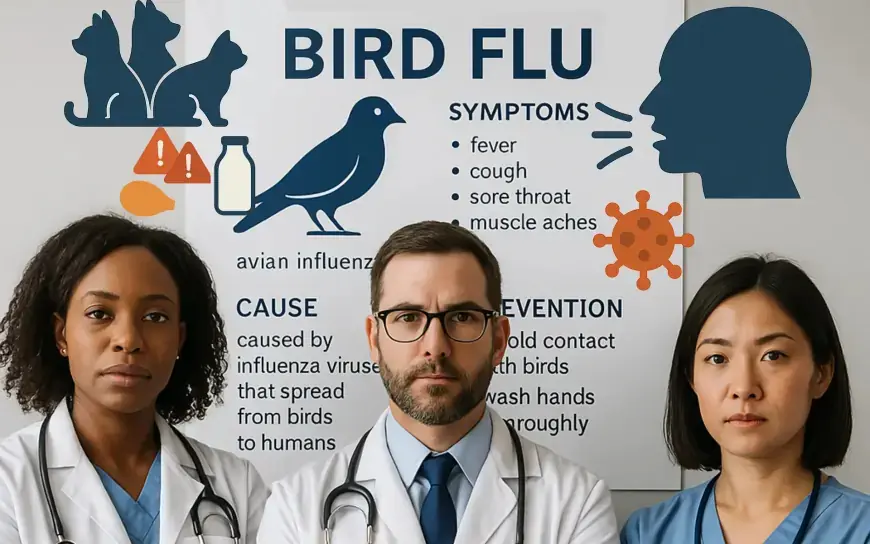Bird Flu: A Comprehensive Guide to Prevention and Protection
Bird flu, also known as avian influenza, is a viral disease primarily affecting birds but can spread to mammals, including humans, cats, dogs, and livestock.

What is Bird Flu? Bird flu, also known as avian influenza, is a viral disease primarily affecting birds but can spread to mammals, including humans, cats, dogs, and livestock. It is caused by influenza type A viruses, which vary in severity depending on the strain. Some strains, like H5N1, have raised concerns due to their ability to infect humans.
Different Strains of Bird Flu
Bird flu viruses are classified based on two proteins on their surface:
- Hemagglutinin (H) – 16 subtypes (H1–H16)
- Neuraminidase (N) – 9 subtypes (N1–N9)
Major Strains of Concern:
- H5N1 – Known for infecting humans and animals, with high fatality rates.
- H7N9 – Previously caused human outbreaks.
- H5N2, H7N2, H7N8 – Variants that affect birds, sometimes crossing to other species.
These strains are classified as:
- Highly Pathogenic Avian Influenza (HPAI) – Causes severe disease in poultry and wild birds.
- Low Pathogenic Avian Influenza (LPAI) – Mild symptoms but can mutate into HPAI.
How Does Bird Flu Spread to Humans?
Bird flu spreads through direct or indirect contact with infected birds or contaminated environments. Some key transmission methods include:
- Contact with infected birds – Handling sick or dead birds increases risk.
- Contaminated surfaces – The virus survives on objects like cages, clothing, and equipment.
- Airborne particles – Infected birds shed the virus through saliva, mucus, and feces.
- Consumption of raw or undercooked poultry, eggs, or unpasteurized milk.
- Exposure to infected mammals – Certain strains have jumped to cats, cows, goats, and dogs.
Human-to-human transmission is rare, but health experts monitor mutations that may increase its spread.
Bird Flu's Impact on Pets and Animals
While bird flu primarily affects birds, some strains, like H5N1, have infected mammals, including pets.
How Pets Can Get Infected
- Eating infected birds or raw animal products – Raw poultry and unpasteurized milk can contain the virus.
- Exposure to infected animals – Outdoor pets interacting with sick birds or livestock face higher risk.
- Contaminated surfaces – The virus can survive on clothing, cages, and pet areas.
Symptoms in Pets
- Fever, fatigue, or loss of appetite.
- Respiratory issues like coughing or wheezing.
- Neurological signs such as tremors or difficulty walking.
- Red or inflamed eyes, nasal discharge.
If any symptoms appear, consult a veterinarian immediately.
Protective Measures for Humans
Hygiene & Prevention
- Wash hands thoroughly after handling birds or pets.
- Disinfect clothing, tools, and surfaces regularly.
- Avoid touching wild birds or visiting poultry farms.
Food Safety
- Cook poultry and eggs thoroughly before consumption.
- Avoid raw dairy or unpasteurized milk.
Health Monitoring
- Look out for flu-like symptoms, including fever, cough, breathing difficulties, and fatigue.
- Seek medical attention if symptoms occur after exposure.
Protective Measures for Pets
Reducing Exposure Risks
- Keep pets indoors to prevent contact with wild birds.
- Avoid feeding raw poultry or unpasteurized milk.
- Maintain clean pet bedding and food bowls regularly.
Recognizing Symptoms in Pets
- Fever, lethargy, or loss of appetite.
- Breathing difficulties, coughing, or nasal discharge.
- Neurological effects such as tremors or weakness.
If symptoms appear, consult a veterinarian promptly.
When Does Bird Flu Outbreak Occur?
Bird flu outbreaks don’t follow a strict seasonal pattern like human flu, but they tend to increase in colder months when birds migrate. However, outbreaks can happen year-round, particularly in areas with dense poultry farming or frequent wildlife interactions.
Final Thoughts
Bird flu outbreaks pose serious risks to both humans and animals, but proactive measures can minimize the chances of infection. By maintaining good hygiene, monitoring food safety, and reducing pet exposure, the impact of the virus can be controlled. Health experts continue monitoring outbreaks, so staying informed is essential.
Follow. Like. Comment anonymously, no account required. And if you love this post and want to show your support, we’d appreciate your TipDrop—whether publicly in the comment section, or through our TipDrop Page. Thank You!
Reward this post with your reaction or TipDrop:
 Like
0
Like
0
 Dislike
0
Dislike
0
 Love
0
Love
0
 Funny
0
Funny
0
 Angry
0
Angry
0
 Sad
0
Sad
0
 TipDrop
0
TipDrop
0




























